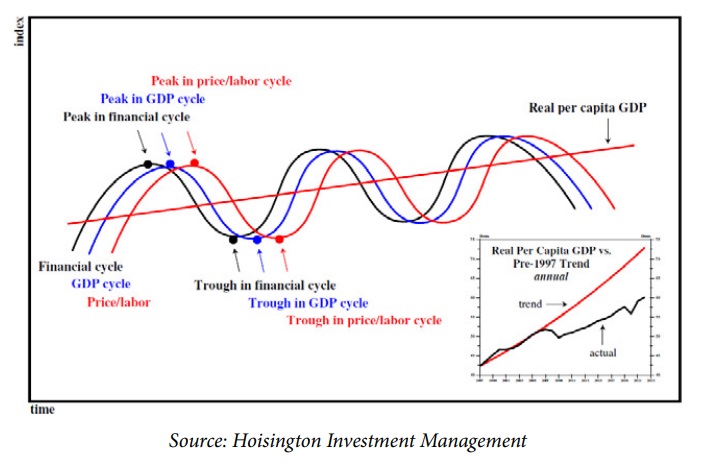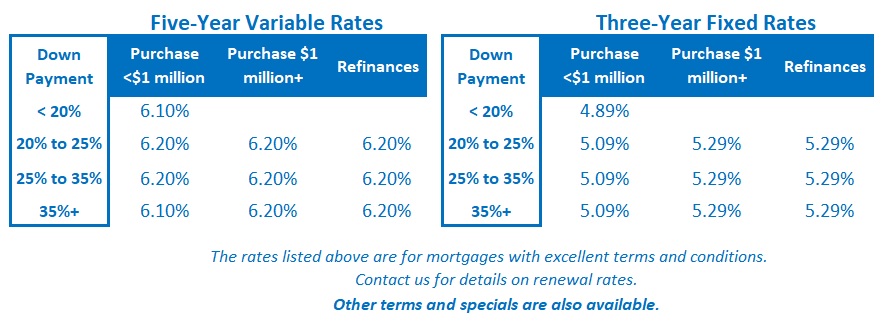Will Last Month’s Inflation Uptick Alter the Bank of Canada’s Plans?
July 2, 2024Easing US Inflation is Good News for Canadian Mortgage Borrowers
July 15, 2024
Last week, Statistics Canada confirmed that our economy lost an estimated 1,400 jobs in June, a major shortfall from the consensus forecast that it would gain 25,000 jobs instead.
The Government of Canada (GoC) bond yields, which our fixed mortgage rates are priced on, fell sharply on the news. The bond futures market responded by increasing the odds of a Bank of Canada (BoC) rate cut at its next meeting on July 24 to a little more than 50%.
The market’s initial reaction to new economic data is worth noting, but if you’re trying to predict where mortgage rates are headed, it is also important to keep an eye on longer term trends. Today’s post will do both.
Let’s start with a look at the highlights from our latest employment report:
- Our unemployment rate has now risen to 6.4%, which is 1.4% above where it bottomed in January 2023. That is noteworthy because unemployment rate increases of more than 1% typically presage recessions.
- The percentage of working-age Canadians who are either working or actively looking for work decreased from 65.4% to 65.3%. That drop was more than offset by the addition of 40,000 new workers to our labour force last month.
- Average hours worked decreased by 0.4%. A pronounced drop like that usually portends disappointing GDP data ahead.
- The proportion of unemployed workers who have been off work for 27 weeks or more increased to 17.6%, about 4% above where it stood a year ago. This is a concerning trend because the longer people are off work, the harder it is for them to reintegrate.
- The year-over-year rise in hourly wages increased from 5.1% in May to 5.4% in June. The rise in average hourly earnings for permanent workers increased from 5.2% in May to 5.6% in June as well. While rising labour costs are inflationary, several economists noted that our wage growth data have been driven higher by base effects, which will soon dissipate. (The base effect is being caused by below-average wage growth last year that will soon age out of the data set.)
Weakening labour-market conditions are what we should expect at this stage of our current interest-rate cycle according to the chart below from Lacy Hunt, Chief Economist at the US investment firm Hoisington Investment Management. This chart illustrates how the business cycle oscillates in three distinct waves. The size and duration of the waves will vary, but their general direction and relationship to each other plays out consistently over long periods of time.
This chart illustrates how the business cycle oscillates in three distinct waves. The size and duration of the waves will vary, but their general direction and relationship to each other plays out consistently over long periods of time.
About a year ago, I overlaid our then current economic data on the chart above. Here is an updated look based on where we are now.
Financial Cycle
The BoC responded to spiking inflation with the sharpest series of rate hikes in modern history. The lags between when the rate hikes occurred and when they started to materially impact our economy were longer this time, but the effects are now being strongly felt. Monetary-policy conditions are drum tight, but the BoC has now started to reverse course and reduce the degree of tightness with its first policy-rate cut.
GDP Cycle
The longer lags allowed our GDP to keep running apace for some time. Our economy was lauded as resilient for as long as some temporary support remained in place. Record levels of immigration kept headline GDP growing (even as GDP-per-capita contracted). Elevated household savings from the pandemic acted as a spending buffer for consumers. Fixed-payment variable-rate mortgages delayed the impact of higher rates on monthly cash flows for borrowers who would otherwise have been among the first impacted.
Today, immigration caps, depleted savings, and mortgage renewals/resets have exhausted those temporary supports. And without them, our GDP growth is stalling out.
Price/Labour Cycle
The first sign of price cooling was a slowing in the rate of above-normal price increases. Now most price increases are occurring within their normal historical ranges, and outright price cuts are starting to occur. At the same time, businesses are less confident in their growth prospects but more confident in their ability to add workers. Not surprisingly, new job postings are declining, and fewer workers are voluntarily quitting their jobs. While we haven’t yet seen the weakening employment situation reflected in wage-growth rates, we will likely see them start to decline in the months ahead.
Mortgage Selection Advice for Now
Now that the BoC has started to reduce its policy rate, and based on where we are in our current interest-rate cycle, I think the odds favour today’s five-year variable-rate mortgages over any of the currently available fixed-rate options. (That said, anyone choosing a variable rate today must be willing to start their term with a higher initial rate and be comfortable with the inherent risk that my rate view may not prove correct.)
Alternatively, I think conservative borrowers are well advised to consider three-year fixed-rate terms. The premiums required for one- and two-year fixed rates remain substantial. While five-year fixed-rate terms are offered at lower rates, I worry that five years may be too long to be locking in when rates are near their cycle peaks.
If you are leaning towards a fixed rate, pay extra attention to the terms and conditions in your mortgage contract. They vary widely from lender to lender and can have a significant and sometimes surprising impact on the overall cost of a loan, especially if rates drop significantly during your term.
My blogs provide lots of detail on that front, and my post entitled What’s in the Fine Print is a good place to start. It provides a detailed summary of the most important terms and conditions to watch out for and links to other posts that delve deeper into more specific topics. The Bottom Line: GoC bond yields moved higher at the start of the week.
The Bottom Line: GoC bond yields moved higher at the start of the week.
One large lender announced a round of small increases to its fixed mortgage rates, as I warned might happen in last week’s post. But then, on Friday, the latest employment data caused bond yields to sharply reverse course, and most lenders held their fixed rates steady.
Interestingly, while GoC bond yields have been volatile of late, they have still fluctuated within a consistent range and have continually reverted to about the level where they now stand.
Variable-rate discounts were unchanged last week. They remain at the wider end of their historical range.
While there has been much speculation about what the BoC will do at its next meeting on July 24 (I think it will cut), the most important development for anyone with an existing variable-rate mortgage is that the Bank’s rate-cut cycle has begun, and a series of additional cuts is on the way.







